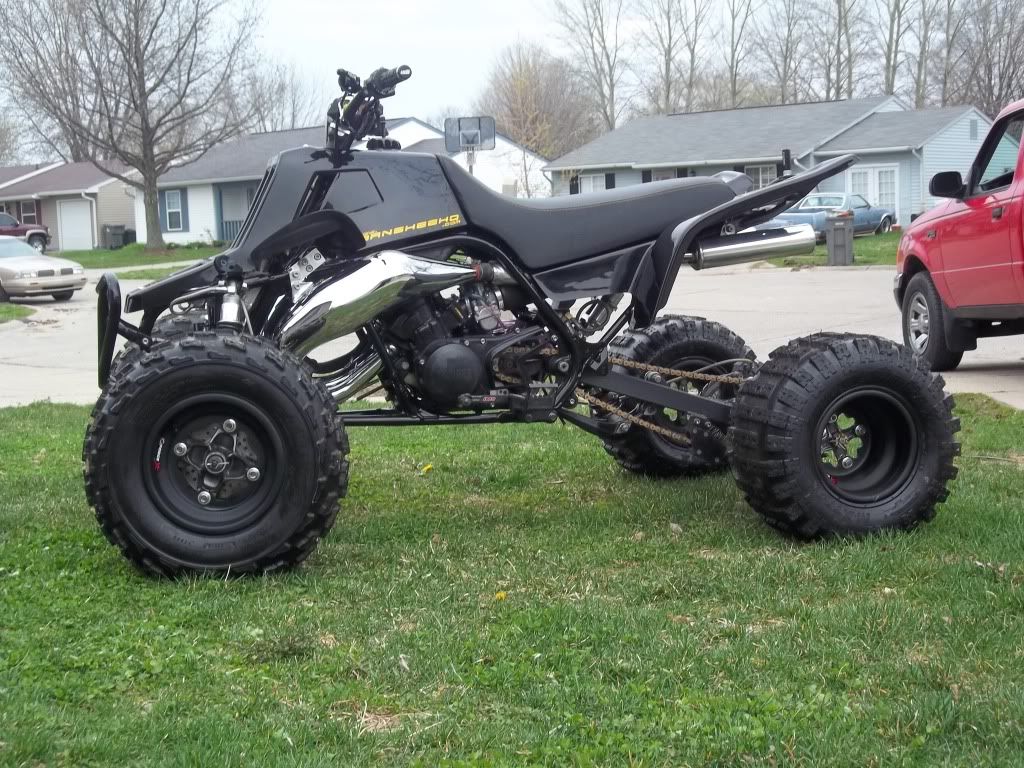Last updated:
The Yamaha Banshee is a 34 horsepower all-terrain vehicle(ATV) weighing 386 lbs manufactured by Yamaha Motor Company from 1987 until 2006. The Banshee 350 has a respectable top speed of 75 mph in stock condition and an average current classifieds price of between $2000 and $3200 US.
Banshee production stopped in 2006 due to economic conditions but it continued to be sold in Canada until 2008 and in Australia until 2012 as 2006 models. The Yamaha Banshee engine notably does not have an electric starter or reverse gear but is still popular because it is fun to ride. Future Banshee restoration projects will ensure that at least a few Yamaha Banshees survive for a very long time. The Banshee 350 is considered a classic sport ATV by collectors.
The Yamaha Banshee 350 is powered by a 347 cc, twin-cylinder, liquid-cooled two-stroke engine. It is 73 inches long, 43.3 inches wide and 42.5 inches tall and seat height stands at 31.5 inches. Visit a used Yamaha ATV dealer near you to test drive a Banshee 350, you just might want to join other Banshee 350 enthusiasts who make it their main ride.
Banshee riders have formed dedicated communities, like BansheeHQ.com forums, to get and share advice on where to find banshee parts, share project updates and build ideas.
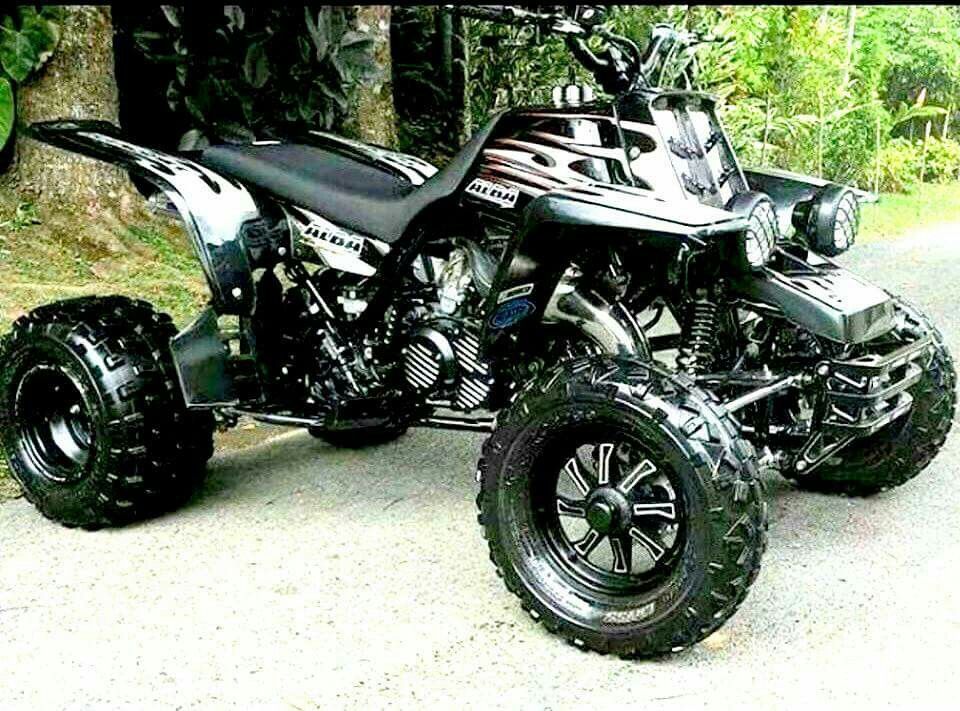 Visit my ATV Value guide page for help in more accurately pricing an ATV.
Visit my ATV Value guide page for help in more accurately pricing an ATV.The Yamaha Banshee’s top speed is 75 MPH in stock condition. Some owners have recorded runs as high as 85 MPH while others say they can reach 82 MPH in 6th gear in various youtube videos. Weather, altitude, type of gas, engine condition, wind direction and tuning are all variables with an impact. A good baseline as to how fast the Banshee 350 can go stands at roughly 75 MPH stock(without high performance parts).
Yamaha Banshee engines are 2-stroke and oil flows through the transmission and clutch. The Banshee requires 1.6 quarts of oil per change. You should always refer to your manual for oil type and amount but if you don’t have a manual you can pick up a Banshee owner’s manual online. Oil capacity is typically stamped on the transmission case but with used ATVs it’s always best to check the manual! There are several brands of oil available, make sure you use “wet clutch” compatible/safe oil that contains no friction modifiers.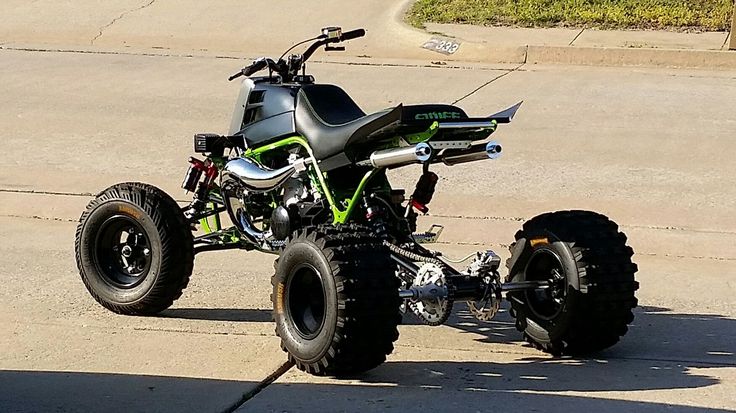
Besides the manual and recommended oil several items are required to make changing your Yamaha Banshee oil simple. These items include a 17mm socket, a torque wrench if you have access to one, an oil funnel, a drain pan and some shop cloth or rags to clean up any spill. Changing the oil on a Yamaha banshee is not difficult, here are the steps:
No, Yamaha ceased production and sale of the Yamaha Banshee in 2006 for economic reasons and increased sport ATV competition.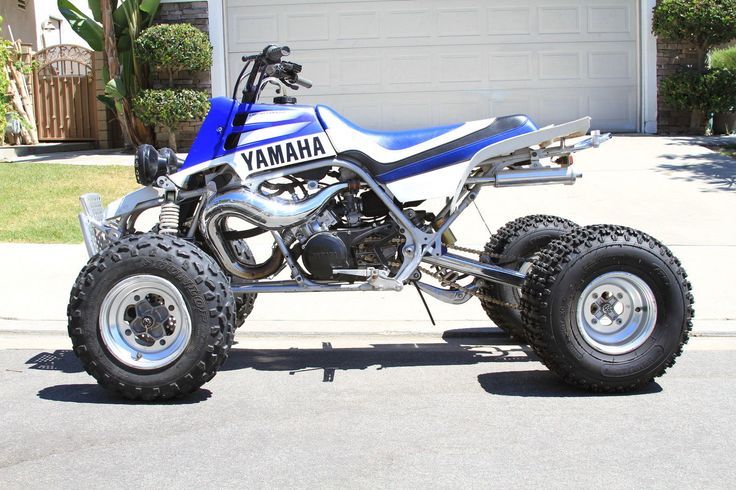 All Yamaha Banshee production has been discontinued indefinitely, however, the market for used Yamaha Banshees for sale remains very strong. It is one of Yamaha’s most popular four wheeler models and has a loyal fan base.
All Yamaha Banshee production has been discontinued indefinitely, however, the market for used Yamaha Banshees for sale remains very strong. It is one of Yamaha’s most popular four wheeler models and has a loyal fan base.
by Matt Powell
Table of Contents
Cast your mind back to the 1970s, when all the motorcycle manufacturers were switching from two-stroke to four-stroke engines, except Yamaha who kept developing the engine that became the RZ350. Jump forward to 1987, when three-wheeled ATVs were on the wane, and quads were all the rage. Yamaha shocked the industry by putting that RZ350 in an off-road quad — the Yamaha Banshee — that went one to be beloved by its cult following. Cult following, history and pedigree aside,
are Yamaha Banshees good quads?
Jump forward to 1987, when three-wheeled ATVs were on the wane, and quads were all the rage. Yamaha shocked the industry by putting that RZ350 in an off-road quad — the Yamaha Banshee — that went one to be beloved by its cult following. Cult following, history and pedigree aside,
are Yamaha Banshees good quads?
The 34-hp, 386 lb, two-stroke Yamaha Banshee is easy to maintain, ideal for dirt and dunes, readily modified, described as virtually indestructible, and often called by off-road enthusiasts as the greatest ATV of all time. Does that make it a good quad? Yes. The endlessly fun Banshee is one good quad.
True as that is, it’s an incomplete answer considering the cult following that worships the Yamaha Banshee despite that new ones haven’t been built in years. Here’s the rest of what you need to know about the Banshee, including its history, production, specs, top speed, criticisms and value.
Everything You Need To Know About The Yamaha BansheeWhat Is The Yamaha Banshee’s History?In the early 1970s, Kawasaki, Suzuki and Yamaha Street bikes mostly had two-stroke engines. As the decade progressed, manufacturers Kawasaki and Sucuki switched to four-stroke, 750 to 1,000 cc engines for street bikes. But not Yamaha. Yamaha kept working on their two-stroke RD400 engine that ultimately became its liquid-cooled RZ350. Ultimately, Yamaha’s RZ350 was the last available two-cylinder street bike. With that status, it developed a cult-like and loyal following.
As the decade progressed, manufacturers Kawasaki and Sucuki switched to four-stroke, 750 to 1,000 cc engines for street bikes. But not Yamaha. Yamaha kept working on their two-stroke RD400 engine that ultimately became its liquid-cooled RZ350. Ultimately, Yamaha’s RZ350 was the last available two-cylinder street bike. With that status, it developed a cult-like and loyal following.
Turning to ATVs, by the mid-1980s, three-wheeled trikes were becoming passe in favour of quads in the marketplace. When Yamaha revealed its quad ATV lineup, the market anticipated one-cylinder 250cc, two-stroke engines like those in Suzuki and Honda’s quads. Yahama went bigger than that and planted its RZ350 engine into a quad ATV. Thus the Banshee — the only twin-cylinder, two-stroke quad on the market — was born.
When And Where Was The Yamaha Banshee Produced?Yamaha produced the Banshee 350 from its Japan plant from 1987 through 2012. In the United States, they were sold from 1987 to 2006.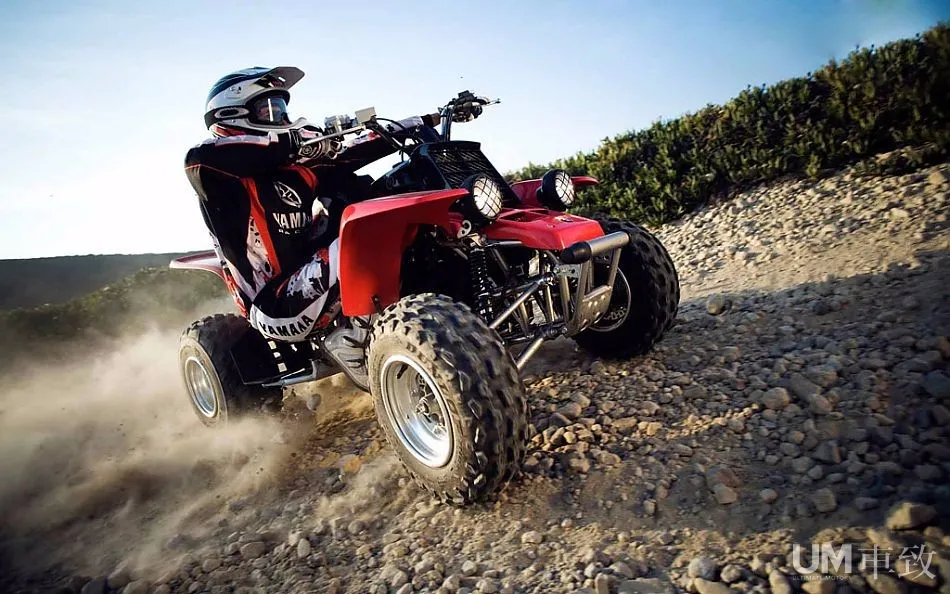 In Canada, new Banshees were sold until 2008. Australians could purchase new Yamaha Banshees from 1998 to 2012. Here are engine and chassis specifications that make the Banshee such a fun ATV.
In Canada, new Banshees were sold until 2008. Australians could purchase new Yamaha Banshees from 1998 to 2012. Here are engine and chassis specifications that make the Banshee such a fun ATV.
| Bore x Stroke: | 64 mm x 54 mm |
| Compression Ratio: | 6.5:1 |
| Drive Train: | RWD; Sealed O-Ring Chain |
| Fuel Delivery: | Dual Mikuni 26 mm |
| Ignition: | CDI |
| Starting System: | Kick |
| Transmission: | 6-speed Manual Clutch |
| Type: | 350 cc, 2-Stroke, Liquid Cooled, Reed Valve 2-Cylinder |
There are two things to notice about the Banshee’s specs, that stand out but do not deter its fans: the absence of an electric starter; and the fact that it has no reverse gear.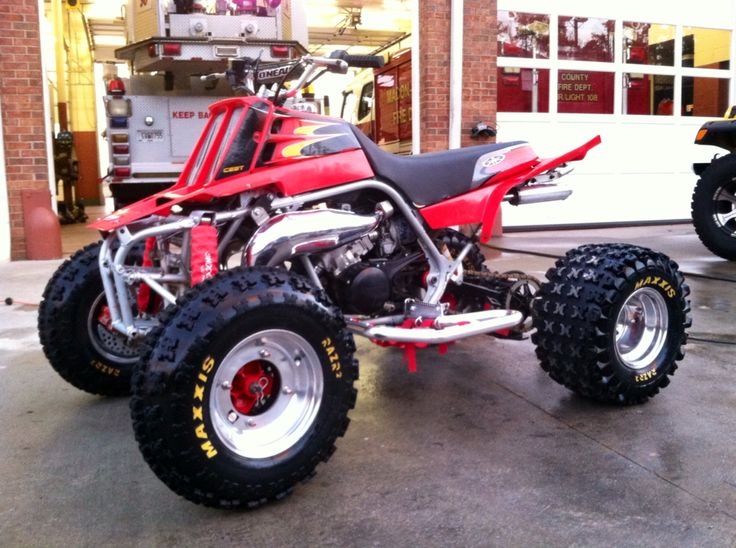 I have personally ridden on a trail with a Yamaha Banshee and the kick starting can be a pain at ties, as well as the no reverse, but it is still an amazing quad to run anywhere with.
I have personally ridden on a trail with a Yamaha Banshee and the kick starting can be a pain at ties, as well as the no reverse, but it is still an amazing quad to run anywhere with.
| Primary ratio: | 66/23, 2.869 |
| 1st gear ratio: | 32/13, 2.461 |
| 2nd gear ratio: | 29/16, 1.812 |
| 3rd gear ratio: | 27/18, 1.500 |
| 4th gear ratio: | 25/20, 1.250 |
| 5th gear ratio: | 23/22, 1.045 |
| 6th gear ratio: | 21/24, 0. 875 875 |
| final ratio: | 41/14, 2.929 |
That combination of engine and transmission specs combine to deliver what makes the Banshee so attractive to so many owners – its sheer power. That power comes from what has been described as an incredible powerband that requires finding its sweet spot. Not every beginner or new driver will be able to hit that sweet spot immediately, something that makes the Banshee a bit of a risk at the outset. Compared to a four-stroke engine, the Banshee’s power can be somewhat unpredictable. ‘Popping a wheelie’ is easy to do until you get used to the engine’s power and when and how it’s delivered to those tires.
What Are The Yamaha Banshee’s Chassis Specifications?| Front Brakes: | Dual Hydraulic Disc |
| Rear Brakes: | Hydraulic Disc |
| Front Suspension: | Independent Double Wishbone, 9. 1″ w/ 5-way Preload Adjustment 1″ w/ 5-way Preload Adjustment |
| Rear Suspension: | Swingarm with Linkage, 8.7″ w/ Rebound, Compression and Threaded Preload Adjustment |
| Front Tires: | AT21 x 7-10 |
| Rear Tires: | AT20 x 10-9 |
What Are The Dimensions Of The Yamaha Banshee?
| Dry Weight: | 386 Lbs. |
| Fuel Capacity: | 3.2 Gallons |
| Ground Clearance: | 5.3″ |
| L x W x H: | 73.0″ x 43.3″ x 42.5″ |
| Seat Height: | 31.5″ |
| Wet Weight: | 405 Lbs. |
| Wheelbase: | 50.4″ |
A stock Yamaha Banshee 350 will reach 75 MPH.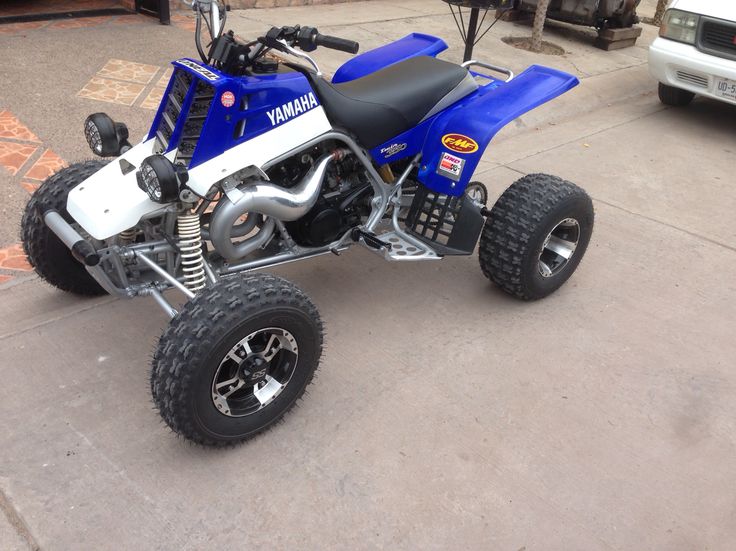 Performance parts are available for the Banshee, and there are many modified versions of the Banshee out there using original and aftermarket parts. You’ll find videos online of some owners reaching 85 MPH. Any ATV’s speed depends on a wide variety of factors, including weather, fuel, condition, altitude, and wind.
Performance parts are available for the Banshee, and there are many modified versions of the Banshee out there using original and aftermarket parts. You’ll find videos online of some owners reaching 85 MPH. Any ATV’s speed depends on a wide variety of factors, including weather, fuel, condition, altitude, and wind.
Some modified Banshees have been stretched into something akin to a drag racer by pulling the wheels far out in front. Some owners, still not satisfied by the Banshee’s enviable power, have made their Banshee even more powerful with a big bore cylinder.
The Banshee is well equipped for dunes and dirt, but not at its best on trails. The rocks, logs and bumps you’ll find on trails require a good and well-tuned suspension. The Banshee has been criticized for not having a top-rate suspension.
The rocks, logs and bumps you’ll find on trails require a good and well-tuned suspension. The Banshee has been criticized for not having a top-rate suspension.
With that being said, if you don’t mind the lack of a good suspension and the bumps along the trail, I would suggest taking your Banshee on the trails anyway because they are just as fun there as the dunes.
There are some criticisms of the Banshee to be sure. Here are a six that come up most often:
 The 350 delivers more power, but consumes more fuel in doing so.
The 350 delivers more power, but consumes more fuel in doing so. Despite those criticisms, though, many ATV enthusiasts consider the Banshee the best ATV ever produced and certainly Yamaha’s best ATV. It has become a staple collector ATV, and a machine easily modified by owners given that Yamaha made very few changes from one model year to another. All these years after the last Banshee was made and sold, they remain among the most popular models, and worth the price. There remains a strong market for re-selling the Banshee, since it has one of the most loyal fanbases of any ATV machine available.
The average price for a used (no new ones have been manufactured since 2012) Yamaha Banshee 350 is in the range of $2,000 to $3,200. As always, the price for any used ATV depends on a lot of individual factors, including the condition and maintenance history of the vehicle. In this case, the Banshee is worth it.
BEST HELMET
BEST GLOVES
BEST BOOTS
BEST GOGGLES
Item
Motif V3 Off-Road Motorcycle Helmet (Men's)
Element MX Gloves
Comp X Motocross Boots (Men's)
Airbrake XL Goggles
Brand
Fox Racing
O'Neal
Fox Racing
Oakley
Check Price
Check Price
Check Price
Check Price
BEST HELMET
Item
Motif V3 Off-Road Motorcycle Helmet (Men's)
Brand
Fox Racing
Check Price
BEST GLOVES
Item
Element MX Gloves
Brand
O'Neal
Check Price
BEST BOOTS
Item
Comp X Motocross Boots (Men's)
Brand
Fox Racing
Check Price
BEST GOGGLES
Item
Airbrake XL Goggles
Brand
Oakley
Check Price
Other Great Articles Unique in sport ATVs, the liquid-cooled, two-stroke, twin-cylinder, 350cc engine with two carburetors and two exhaust systems allows this ATV to develop breathtaking acceleration, leaving absolutely everyone in its class in the tail. Its race-style independent front suspension with spring preload provides 23 cm of travel, while the variable-rate rear suspension has a remotely adjustable shock absorber with 22 cm of travel.
Its race-style independent front suspension with spring preload provides 23 cm of travel, while the variable-rate rear suspension has a remotely adjustable shock absorber with 22 cm of travel.
| Engine | |
| Engine type | 4 stroke |
| Ignition | Electronic CDI |
| Engine size | 399 cm³ |
| Engine power | 28.9 HP |
| Transmission | |
| Transmission | Automatic |
| Fuel System | |
| Fuel supply | injector |
| Fuel tank capacity | 16 |
| Performance | |
| Fuel | AI-92-95 |
| Frame | |
| Frame material | steel |
| Suspension | |
| Front suspension | independent |
| Rear suspension | independent |
| Wheels | |
| Front tire? | 10 |
| Rear tire? | 10 |
| Key Features | |
| Year of manufacture | 2016 |
| Country | Japan |
The idea of this comparative test was born long ago, on New Year's Eve. Toast after toast, word by word, the argument began that a sports ATV could easily do any sports hatchback. By simple arithmetic calculations, it was revealed that the specific power per 1 ton for an ATV is 262 hp / t, and for a hot hatchback it is only 128 hp / t. But first things first...
By simple arithmetic calculations, it was revealed that the specific power per 1 ton for an ATV is 262 hp / t, and for a hot hatchback it is only 128 hp / t. But first things first...
Two of our participants are bright personalities in their incarnations. They have one thing in common: they are both discontinued, both have a minimum of electronics and are adrenaline generators.
Which of them will confirm the title of a true adrenaline generator?
Honda Civic Si does not have any electronic driving assistance systems other than ABS. On a slippery road, a new generation of drivers who are accustomed to the traction control and stabilization system will find it a skittish beast. And in order to move on it very quickly, you need to keep the engine near the red zone in the region of 7000 rpm. And you need to wield the lever very quickly, due to the fact that the box has close gear ratios.
We had a version of the Honda Civic Si with a 160 hp 2.0 liter engine.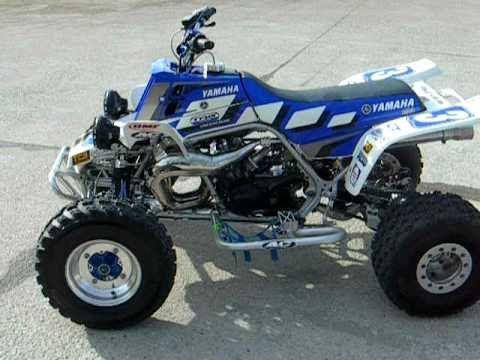 But what about the 200-horsepower Civic Type R, you ask? Unfortunately, we did not have the opportunity to find the seventh generation Civic Type R in Chelyabinsk, so we had to be content with what we had.
But what about the 200-horsepower Civic Type R, you ask? Unfortunately, we did not have the opportunity to find the seventh generation Civic Type R in Chelyabinsk, so we had to be content with what we had.
The main difference between the Civic Si and the Type R is, of course, the engine and the absence of 6th gear, but everything else remains: the same sharp steering wheel, sensitive gas pedal, excellent neutral steering, suspension that does not allow rolls.
The Yamaha 350 Banshee is a true sport ATV. At competitions in the USA and Canada, most riders use the Banshee, albeit with minor modifications.
The engine's power is over 50 hp, assisted by a six-speed manual.
At first glance, the Yamaha 350 Banshee seems like a child, just a toy: small and low (as it turned out, to reduce the center of gravity), with small wheels (for better acceleration).
This is the "Spirit of Death" - that's how Banshee is translated.
Exterior
The design of the Honda Civic Si looks classic for early 2000s hatchbacks.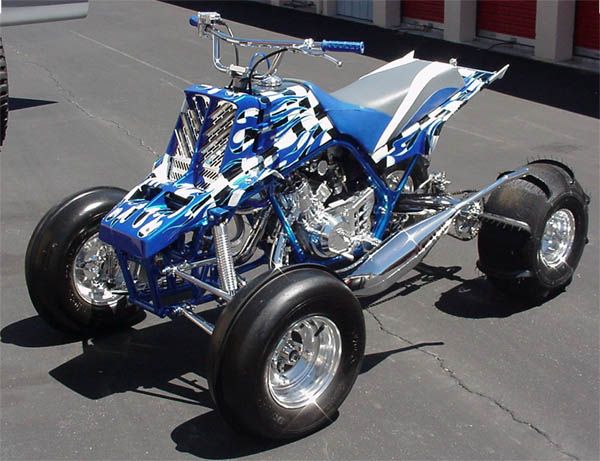 The short hood looks unusual, which, together with the windshield, represents a straight line, and the fifth door goes down sharply. In profile, the car resembles a wedge, which has a good effect on aerodynamics. Regular shapes are complemented by flared rear arches and twin tailpipes.
The short hood looks unusual, which, together with the windshield, represents a straight line, and the fifth door goes down sharply. In profile, the car resembles a wedge, which has a good effect on aerodynamics. Regular shapes are complemented by flared rear arches and twin tailpipes.
Yamaha looks nowhere simpler: simple fender liner, humpbacked nose from the cooling radiator and two standard round headlights. There are no beautiful nose cones, curved headlights, and why, because at a speed of 90 km/h, few people can see you between the edges of the forest. A trip in a calm state is doomed to failure, the ATV either languishes or rushes like dumbfounded, it won’t be able to ride tight. So a quiet walk through the forest will not work.
Propulsion
The ATV's engine is the only two-stroke, two-cylinder, two-carburetor, liquid-cooled engine in the ATV. In the 80s, this air-cooled motor was on a road bike.
Two-stroke engines are loved for their instant response to gas, fast acceleration and, of course, for the characteristic smell of the exhaust (a mixture of oil, gasoline and exhaust). The throttle grip is very sensitive - you pushed it 1 mm, and the quad already wants to rear up, carrying you at breakneck speed. The thumb must be strong enough to hold the throttle in the depressed position for a sufficient amount of time, adding nervousness to the ATV's behavior of the short-stroke clutch handle - all together it turns into a "spicy cocktail". Probably, there are a few people who were able to start on the Banshee the first time without stalling or rearing up.
The throttle grip is very sensitive - you pushed it 1 mm, and the quad already wants to rear up, carrying you at breakneck speed. The thumb must be strong enough to hold the throttle in the depressed position for a sufficient amount of time, adding nervousness to the ATV's behavior of the short-stroke clutch handle - all together it turns into a "spicy cocktail". Probably, there are a few people who were able to start on the Banshee the first time without stalling or rearing up.
The Civic's engine is good: great low-end traction is accompanied by an equally great high-pitched soundtrack, and the tachometer needle starts flying furiously towards the red zone. Still, earlier Hondas made real, clockwork motors. You can, for example, recall the famous four-cylinder B16 engine with a volume of 1.6 and power from 160 to 185 hp. in various specifications, but this motor deserves a separate article.
Honda's acceleration among naturally aspirated engines is the most exciting: 3000, 4000, 5500 and the tachometer arrow is moving to 7000 rpm, the next gear and acceleration continues.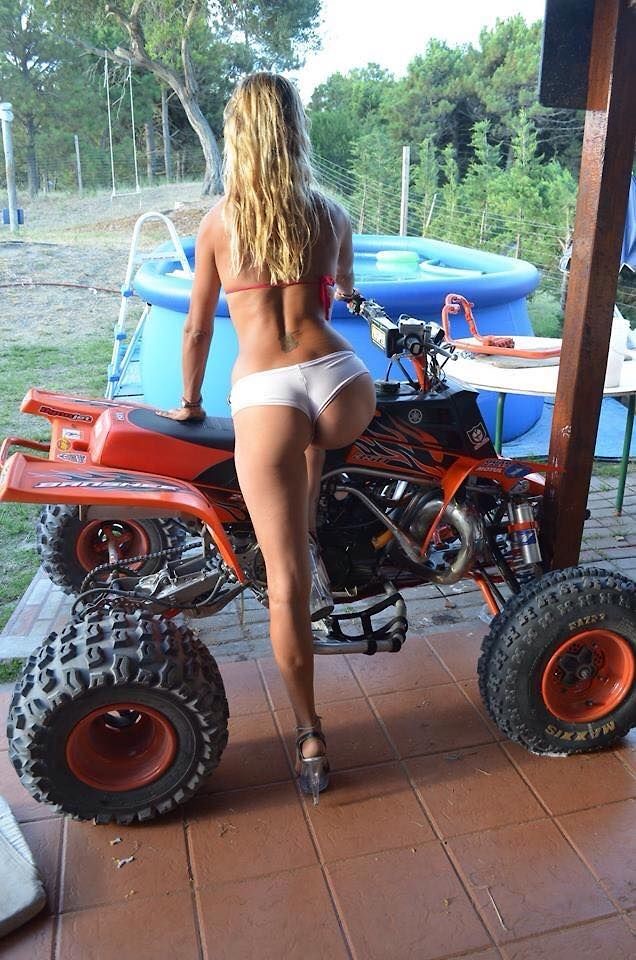 Since the main pair of the box is 4.76 (!), Fast and accurate switching is required, otherwise the motor will quickly hit the rev limiter.
Since the main pair of the box is 4.76 (!), Fast and accurate switching is required, otherwise the motor will quickly hit the rev limiter.
Competition
In order to somehow compare these two diverse vehicles, it was decided to conduct a series of comparative tests: acceleration over a distance of ¼ mile, snake, and braking.
After the first start, it became clear that there was nothing to do at 402 meters: a sports ATV, designed for speeds up to 100 km / h, after 200 meters starts to lag far behind, so it was decided to run 200 meters races.
The go-ahead, start, and there was no trace of the toy charm of the ATV: Banshee, like a scalded man, jumped forward 60 meters when the car managed to overcome only five meters. It seems everything, the outcome is a foregone conclusion, but, having coped with the slip, the Civic begins to rapidly pick up speed, at 150 meters the car and the ATV are equal, and the Honda easily goes ahead. In total, about 6 races were held, but the result did not change: 1 victory for the ATV and all the rest for the car.
The ATV pilot's attempts to quickly leave the start revealed a problem - the ATV tried to rear up, while the driver was losing precious seconds by slowing down the gas.
When starting from a standstill, the Yamaha 350 Banshee jumped 60 meters ahead, but by 150 meters the car and the ATV caught up, and the Honda Civic Si began to move away from the pursuer.
The main weapon of the Honda Civic Si is Ultra High Performance Summer (UHP), BFGoodrich g-Force T/A KDW2 summer tires, but they were only useful on the snake and partly on braking. At the start, they began to skid heavily, and at a temperature of -1 o C (competitions were held under such weather conditions), it was almost impossible to warm them up. And after several starts, it became noticeable that the tire was made using different types of rubber, this was evident both on the tracks left on the asphalt and on the tire itself: black rubber along the edges and in the center, and brown stripes between them.
On the other hand, peak overloads g on an ATV during acceleration are much greater. And what an acceleration! 1st gear and the quad rears up, crushing acceleration, 2nd gear, the avalanche of acceleration carries you forward, 3rd, the speed already seems beyond the sonic, all thanks to the finely tuned dual exhaust and wind noise.
The driver of an ATV experiences the same thing - just that his face is hidden behind a mask!
The next test was a snake, the car driver wanted to set the distance between the cones 20 steps (17 meters), and the ATV driver 10 steps (7 meters). But the general council decided to put the cones at a distance of 17 steps (14-15 meters).
Driving a quad bike quickly requires coordinated steering and body work. The record for passing was 10 seconds, but a beginner will not pass even in 15 seconds - it is so difficult to control an ATV on asphalt.
The Civic drove through the snake in 11.7 seconds, a faster run was hampered by a rapid avalanche of steering effort.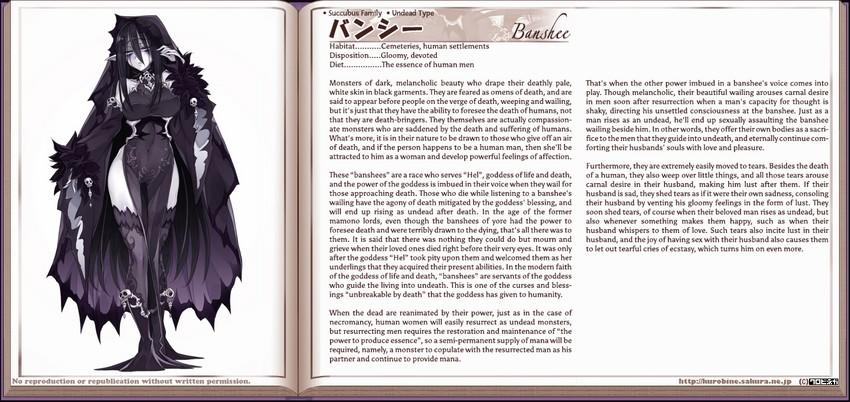 With a successful passage, it was possible to reset another half a second, but this would not change the picture. After all, the ATV has a small mass, which contributes to a smaller moment of inertia.
With a successful passage, it was possible to reset another half a second, but this would not change the picture. After all, the ATV has a small mass, which contributes to a smaller moment of inertia.
The last test after the snake was braking. Considering that the tires on the ATV have low pressure, and when braking from high speed, they can bend on the pavement (which is clearly not safe), it was decided to brake from a speed of 60 km/h. In addition, the sports ATV has separate control of the rear and front brakes (like on motorcycles), therefore, you need to accurately dose the effort on the foot and hand brakes. As it turned out in practice, this is not easy, in the first braking run the ATV driver forgot to press the front brake and rolled 10 meters further than the car, but already in the second run the difference was only half a meter.
After all the tests, it became clear that the ATV felt uncomfortable on the pavement: the low-pressure tires were constantly tucked up, and it was almost impossible to throw off the rider.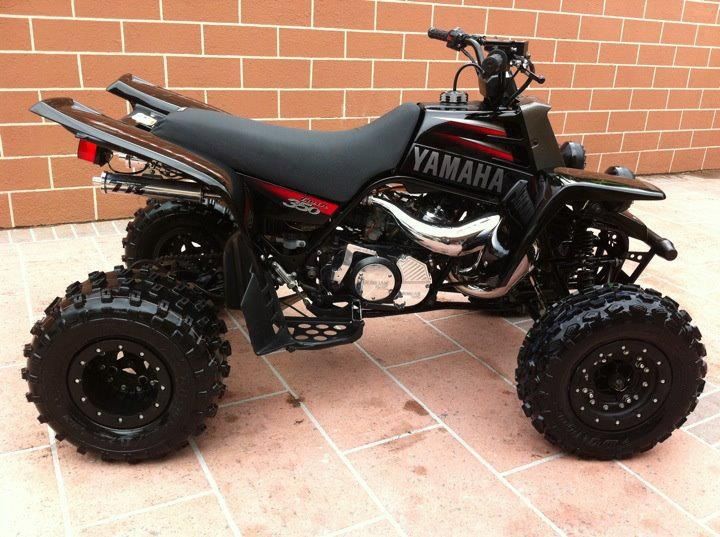 The element of the ATV is off-road, where it feels great, the long-travel suspension handles all the bumps properly, and the low-pressure tires also serve as a good damping element, while holding the soil perfectly.
The element of the ATV is off-road, where it feels great, the long-travel suspension handles all the bumps properly, and the low-pressure tires also serve as a good damping element, while holding the soil perfectly.
Honda Civic Si's element is asphalt. The driver of the car refused to go off-road, awarding victory on the ground to the ATV.
Conclusions
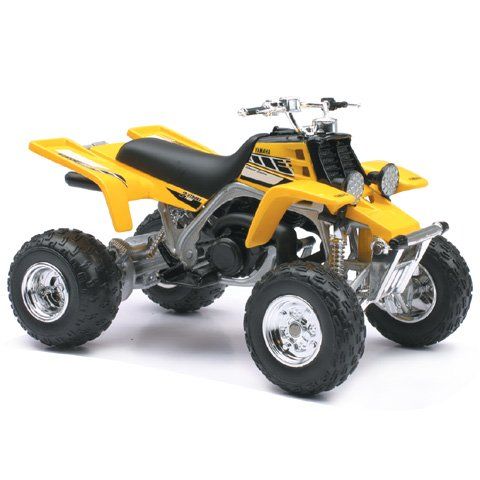 The sensations are so strong that after that the Civic seems insipid.
The sensations are so strong that after that the Civic seems insipid.
Even the "hot" hatchback after the "red demon" seems like a real family car.
Frivolous comparisons
Seats
Yamaha 350 Banshee seat - leather, off-road instantly covered with mud. It has absolutely no lateral support, so you have to hold on to the steering wheel with all your might - otherwise you will fall.
Honda's factory Recaro seat has a great profile and excellent grip in corners
Controls
Sport quad handlebar controls are a mix between motorcycle and utility quad: a motorcycle clutch handle paired with an ATV coin-operated throttle.
The Civic has the same steering wheel as the S2000. Small and thin enough, but with pleasant tides.
Gauges
Si gauges are concise and informative enough, they glow bright red at night.